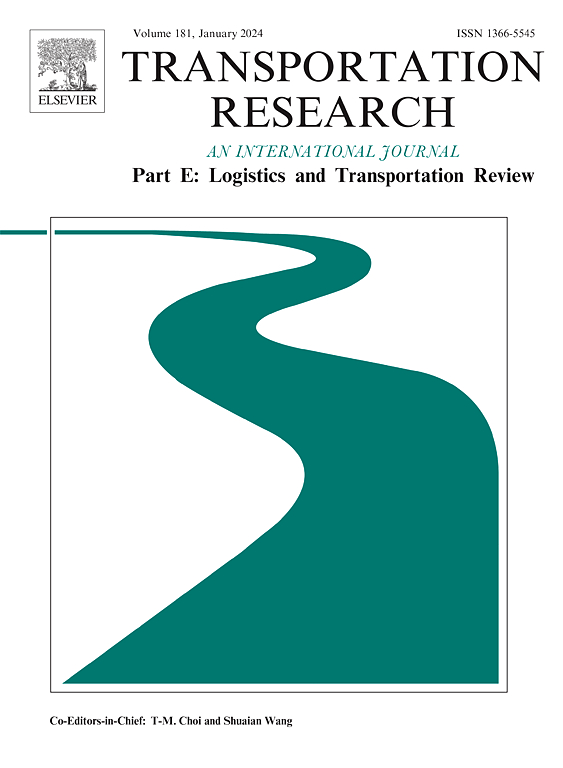碳交易制度下的碳汇:植物组织培养技术共享的时机选择与制造商的最佳模式选择
IF 8.8
1区 工程技术
Q1 ECONOMICS
Transportation Research Part E-Logistics and Transportation Review
Pub Date : 2025-09-26
DOI:10.1016/j.tre.2025.104432
引用次数: 0
摘要
随着现代农业的发展,植物组织培养技术已被越来越多的生产厂家应用。我们在这项工作中考虑了一个由两个制造商组成的农业供应链,其中一个是常规制造商,另一个是拥有植物组织培养(PTC)技术的制造商(PTC制造商)。后者可以与前者以收入分成或产品前销售模式共享这一技术。本文的主要研究问题是分析是否引入PTC技术,以及收益共享模式和预产品销售模式的选择。首先,在收益共享模式下,采用该技术的常规制造商的最优利润总是增加的,而PTC制造商在低(高)单位碳吸收率下共享该技术后的最优利润是增加(减少)的。在预产品销售模式下,在PTC数量功率低(高)时,常规制造商采用该技术后的最优利润减小(增加),而PTC制造商在共享该技术后的最优利润总是增加的。第二,在收入分成率较低的情况下,常规(PTC)制造商在预产品销售模式下的最优利润低于(高于)收入分成模式。然而,我们有趣地发现,在高收益分成率下,在单位碳吸收量低(高)时,常规制造商在产品前销售模式下的最优利润高于(低于)收益分成模式。相反,对于PTC制造商来说,结果正好相反。此外,我们还做了几个扩展。本文章由计算机程序翻译,如有差异,请以英文原文为准。
Carbon sinks under carbon trading system: Timing of plant tissue culture technique sharing and optimal mode selection for a manufacturer
With the development of modern agriculture, the plant tissue culture (PTC) technique has been applied by more and more manufacturers. We in this work consider an agricultural supply chain consisting of two manufacturers where one is a regular manufacturer and the other is a manufacturer that owns the plant tissue culture (PTC) technique (PTC manufacturer). The latter may share this technique with the former in either revenue-sharing or pre-product selling modes. The main research questions of this paper are to analyze whether to introduce the PTC technique, and the selection of revenue-sharing mode and pre-product selling mode. First, in the revenue-sharing mode, the optimal profit of the regular manufacturer adopting this technique always increases while the optimal profit of the PTC manufacturer increases (decreases) after sharing this technique at the low (high) unit carbon absorption. In the pre-product selling mode, the regular manufacturer’s optimal profit decreases (increases) after adopting this technique at the low (high) PTC quantity power, while the PTC manufacturer’s optimal profit always increases after sharing this technique. Second, at the low revenue-sharing rate, the optimal profit of the regular (PTC) manufacturer is lower (higher) in the pre-product selling mode than in the revenue-sharing mode. Nevertheless, we interestingly discover that at the high revenue-sharing rate, the optimal profit of the regular manufacturer is higher (lower) in the pre-product selling mode than in the revenue-sharing mode at low (high) unit carbon absorption. In contrast, for the PTC manufacturer, the opposite result holds. In addition, we make several extensions.
求助全文
通过发布文献求助,成功后即可免费获取论文全文。
去求助
来源期刊
CiteScore
16.20
自引率
16.00%
发文量
285
审稿时长
62 days
期刊介绍:
Transportation Research Part E: Logistics and Transportation Review is a reputable journal that publishes high-quality articles covering a wide range of topics in the field of logistics and transportation research. The journal welcomes submissions on various subjects, including transport economics, transport infrastructure and investment appraisal, evaluation of public policies related to transportation, empirical and analytical studies of logistics management practices and performance, logistics and operations models, and logistics and supply chain management.
Part E aims to provide informative and well-researched articles that contribute to the understanding and advancement of the field. The content of the journal is complementary to other prestigious journals in transportation research, such as Transportation Research Part A: Policy and Practice, Part B: Methodological, Part C: Emerging Technologies, Part D: Transport and Environment, and Part F: Traffic Psychology and Behaviour. Together, these journals form a comprehensive and cohesive reference for current research in transportation science.

 求助内容:
求助内容: 应助结果提醒方式:
应助结果提醒方式:


